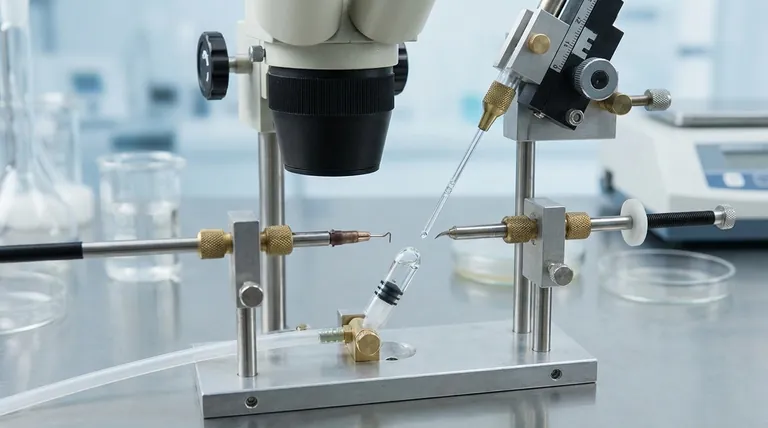To properly maintain the syringe tip during semen collection, it must be kept moist with saline to prevent the sample from drying upon contact. However, it is critical to avoid excess saline, which can dilute the semen. The standard technique involves first drawing a small air space into the syringe to create a barrier between the saline-moistened tip and the incoming sample.
The core challenge in semen collection is balancing the need for a moist environment to protect sperm cells against the risk of diluting the sample. The solution is a simple but critical technique: using a small amount of saline for moisture, separated from the semen by a pocket of air.

The Core Principle: Preserving Sample Integrity
The goal of any collection technique is to retrieve a sample that is a true representation of the source, both in concentration and viability. The handling of the syringe is the first and most critical step in achieving this.
Why Saline is Necessary
Spermatozoa are living cells that are extremely sensitive to their environment.
Exposing them to a dry surface, even for a moment, can cause rapid dehydration and osmotic shock, a form of cell damage that can kill the sperm or render them immotile.
Moistening the syringe tip with a physiologically balanced saline solution prevents this damage.
The Danger of Excess Saline
While moisture is essential, too much saline will dilute the semen sample upon collection.
This dilution immediately compromises the accuracy of any subsequent analysis. Sperm concentration (count) and motility assessments will be artificially low, potentially leading to incorrect diagnostic conclusions or failed insemination attempts.
The Air Gap Technique: A Simple Solution
The most effective method to prevent both drying and dilution is the air gap technique.
Before collection, a small amount of saline is drawn into the syringe to wet the inner surfaces, and then it is expelled, leaving only a residual coating.
Crucially, a small air space (an air bubble) is then drawn into the syringe before aspirating the semen. This air pocket acts as a physical barrier, separating the semen from any residual saline at the syringe hub and ensuring the collected sample remains undiluted.
Common Pitfalls to Avoid
Proper technique is straightforward, but errors can significantly compromise the sample. Understanding these risks reinforces the importance of the correct protocol.
Pitfall 1: The Dry Syringe
Using a completely dry syringe is a common mistake driven by the fear of dilution.
This approach exposes the first portion of the ejaculate to a dry plastic surface, causing immediate cell death and adherence. It results in a non-representative sample with falsely decreased motility and count.
Pitfall 2: The Over-wetted Syringe
Conversely, leaving a visible droplet or column of saline in the syringe is equally detrimental.
This will inevitably mix with the semen, causing significant dilution. For diagnostic purposes, this makes the sample unusable for accurate quantitative analysis.
A Step-by-Step Protocol for Optimal Collection
To ensure the highest quality sample, whether for analysis or insemination, follow a precise and deliberate methodology.
- If your primary focus is sample viability (for insemination): The priority is preventing cell death, making the saline-moistened tip absolutely critical to avoid osmotic shock.
- If your primary focus is accurate analysis (for diagnostics): The priority is preventing dilution, making the air gap technique essential for an uncompromised sperm count and motility evaluation.
Mastering this simple collection technique is the foundation for obtaining a viable and accurate semen sample.
Summary Table:
| Goal | Key Action | Why It's Important |
|---|---|---|
| Prevent Osmotic Shock | Moisten tip with saline | Protects sperm cells from dehydration and death upon contact with a dry surface. |
| Prevent Sample Dilution | Create an air gap before collection | The air bubble acts as a barrier, ensuring the semen sample remains undiluted by residual saline. |
| Ensure Sample Integrity | Follow the step-by-step protocol | Guarantees the collected sample is viable for insemination and accurate for diagnostic analysis. |
Need reliable equipment for your semen collection and analysis workflow? HONESTBEE supplies high-quality beekeeping supplies and equipment to commercial apiaries and distributors through our wholesale-focused operations. Ensure the accuracy and success of your procedures with our durable and precise tools. Contact our experts today to discuss your specific needs and benefit from our wholesale pricing.
Visual Guide

Related Products
- Queen Bee Artificial Insemination Instrument Equipment for Instrumental Insemination
- Professional Queen Catcher and Introduction Queen Cage
- Plastic Chinese Queen Grafting Tool for Bee Queen Rearing
- Professional Spring-Action Queen Catcher Clip
- Plastic Long Marker Device for Catching and Marking Bees Queen Bee Marking Tube and Cage
People Also Ask
- What is instrumental insemination's role in bee breeding? Master Genetic Control for Superior Honey Bees
- What factors influence queen quality for successful artificial insemination? Master the Biological Foundation for High-Yield Colonies
- How long does it take to master instrumental insemination? A 2-Year Journey to Queen Rearing Proficiency
- What are the methods for controlling honey bee mating? Mastering Genetic Selection for Your Apiary
- What is the basic process of artificial insemination in honey bees? A Guide to Controlled Breeding for Superior Genetics



















